Apple M1 Chip: Specs, Performance, Everything We Know
How does Apple’s first Silicon chip stack up against x86?
Apple’s new in-house M1 chip is officially on the market. The first reviews and benchmarks are starting to pop up, so we’re gathering everything we know about it into one handy place, which we’ll update as we learn more.
If you're looking for the M1 Pro and M1 Max, check out our separate explainer on those chips.
Apple M1 Cheat Sheet: Key details at a glance
| Release Date: | Ships Week of 11/16 |
| Found in: | MacBook Air, MacBook Pro, Mac Mini, iMac, iPad |
| Architecture: | Arm-based |
| CPU Cores: | 8-core CPU |
| Nm Process: | 5nm |
| Graphics: | Integrated 8-core GPU with 2.6 teraflops of throughput |
| Memory: | 8GB or 16GB of LPDDR4X-4266 MHz SDRAM |
Apple M1 Release Date
The first computers with Apple's M1 chip are already up for purchase. To try it, you’re going to have to choose between one of the three new products that feature the chip: the new MacBook Air, the 13-inch MacBook Pro or the Mac Mini. Each comes with two configurations using the M1. The MacBook Pro also still has two Intel configurations on offer, and the Mac Mini has one Intel processor offering.
Apple also announced on April 20th that it will be introducing a new M1 iMac and M1 iPad. Unlike previous M1 products, these will be built from the ground up with the M1 in mind, incorporating new, thinner chassis thanks to the M1's greater efficiency. Orders for these new M1 products will open up on April 30th, and will start shipping out to buyers in May.
Apple M1 Price
The M1 is an in-house Apple chip, so you're going to have to get it built into one of Apple's machines rather than standalone.
The Mac Mini starts at $699 with 256GB of storage, making it the cheapest way to get an M1 processor. The price range stretches all the way to $2,099, which will net you the 13-inch MacBook Pro with 2TB of storage.
Pricing is largely down to the specifics of your purchase. But so far, it doesn’t seem like M1 Macs will be significantly more expensive than Intel-based Intel counterparts. The M1 MacBook Air configuration that is most similar to the Intel MacBook Air we reviewed earlier this year is $1,249, for instance, which is $50 cheaper than last year's version. The $999 starting price remains unchanged.
Apple M1 Specs
Here’s the M1’s bread-and-butter. What does Apple’s new Arm-based chip have that Intel’s x86 architecture doesn’t? Well, it uses a 5nm process, for one. By comparison, even Intel’s 7nm process isn’t expected to start hitting its products until at least 2022. Apple's CPU has 8 cores, which would typically require you to step up to Intel's H-series product stack to get on mobile chips.
Four of the M1’s cores are dedicated to high-power performance, while the other 4 are for low-power efficiency. That evens out to a 10W thermal envelope overall, with the low power cores supposedly taking up a tenth of the power needed for the high-power cores. The chip also has a total of 16 billion transistors.
The M1 is also a system on a chip (SOC) with integrated graphics and onboard memory. The included GPU has 8 cores as well, with 128 total compute units and 2.6 teraflops of throughput (there is one exception here: the entry level MacBook Air uses a version of the M1 with a 7-core GPU). The “unified memory” replaces the need for separate RAM, meaning that the chip comes with either 8GB or 16GB of LPDDR4X-4266 MHz SDRAM, depending on your device.
The M1 also has a separate 16-core neural engine for machine learning tasks.
Apple M1 Teardown
If you're curious what the M1 chip actually looks like, Twitter user @technalye1 has done a teardown on their account.
これがApple Silicon M1の電源IC その2配置からインターフェース関連の電源制御っぽいけど、これも開封!開封してM1の開封した写真と並べれば、たぶん用途分かると思う💙 pic.twitter.com/rZXlXExphdNovember 17, 2020
Here's what the M1 actually looks like inside a product, once you take it's top off and remove the thermal paste. The Apple logo's a nice touch, even if it most users will never see it. For comparison, here's what Apple's mock-up of the chip on its own website looks like.
Get Tom's Hardware's best news and in-depth reviews, straight to your inbox.
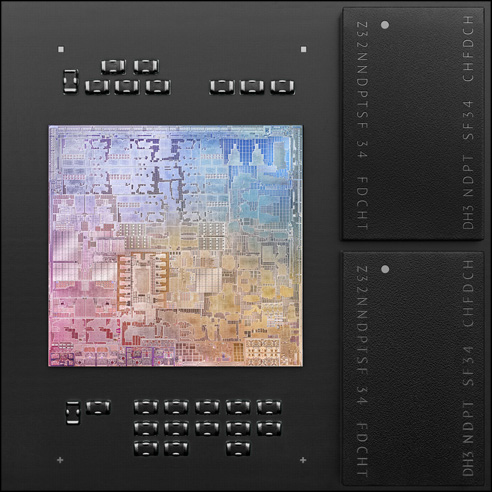
You'll notice it looks pretty different, but that's because this version of the chip is fully enclosed. @technayle1 also has pictures of the chip from the bottom, showing off its pin connectors, and they tend to line up more evenly with Apple's promo images.
左がApple Silicon M1右がA12Z BIONIC一番見たいのはプロセッサー?いやいやガラエポでしょ!!プロセッサーはA14 との比較で十分。とにかくガラエポの観察が楽しみ〜 pic.twitter.com/dterCPPgFcNovember 17, 2020
Apple Silicon M1 なんだけどさ2502ピン!ピンピッチは0.45ひゃーだね pic.twitter.com/Ntaw2yI900November 18, 2020
Finally, @technayle1 also has photos of what the M1 actually looks like when situated into motherboards.
上がMacBook ProのM1取り外し〜下が春発売のiPad ProのA12Z取り外し〜パッシブ配置も、周りの回路構成もむっちゃ似てる!!A12ZはGPU8コアだし、M1配線層剥離したら並べて比較してポスターにしよう!! pic.twitter.com/JcL3yZHAglNovember 17, 2020
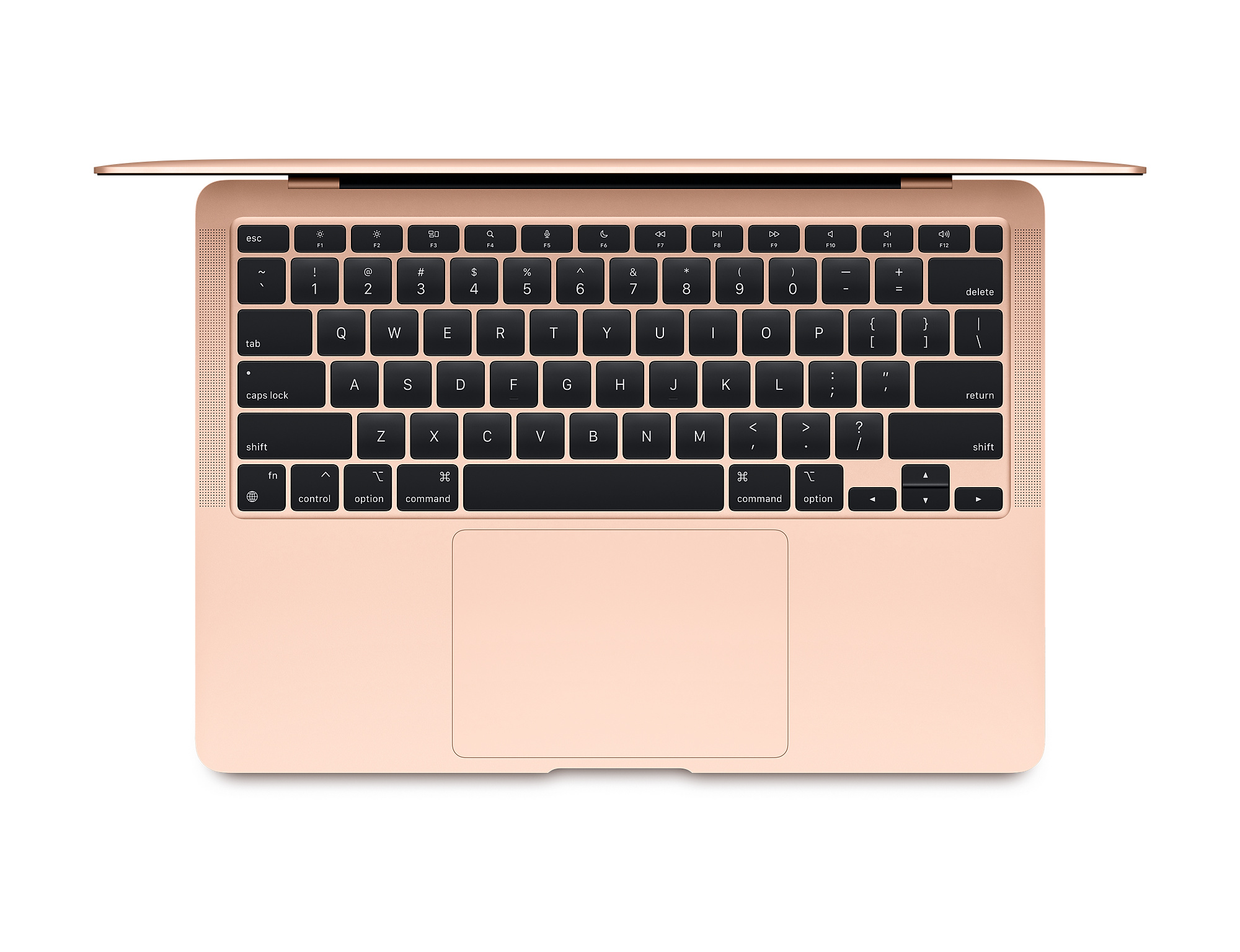
Apple M1 Native Performance
The core drawback to the M1 chip right now is that, because it uses a different architecture and instruction set from Intel or AMD parts, it won’t be able to run x86 apps without emulating them. Developers are already on the case, with Microsoft having released a version of Microsoft Office that runs natively on M1 machines and Adobe saying that it’s working on an M1-native creative suite. The company's even already released an M1-native Photoshop, which it says runs 1.5x faster than the old version does on "similarly configured previous-gen systems." But early adopters might have to wait a bit to get the most performance they can out of their new chips.
When the M1 does get to run natively, though, it seems to pack some serious power. Engadget reports that the M1 MacBook Air had Geekbench 5 results of 1,619/6,292. That’s well above their results for the 2020 i7 MacBook Air, which were 1,130/3,053. Meanwhile, the Tiger Lake Dell XPS 13 9310 scored in 1,496/5,254 on our own Geekbench 5.0 benchmarks, while the ThinkPad X1 Carbon Extreme Gen 3 with an Intel Core i7-10850H chip scored 1,221/6,116.
The M1’s single-core score also beats the 27-inch 2020 Core i9 iMac’s single-core score, which only hit 1,246. It loses out to the iMac’s 9,046 multi-core score, but that officially gives the M1 higher single-core test results out of any Intel Macs, even desktops.
Outlets like The Verge also tested the M1, but under different conditions. Using a MacBook Pro and testing with Geekbench 5.3, The Verge found its review unit scored 1,730/7,510 points.
We’re curious to see how the M1 stacks against a potential 8-core Tiger Lake chip down the line, as well as AMD’s new Ryzen 5000 processors, which are also looking to take Intel’s CPU crown. For now, though, the M1 is looking to be the fastest chip you can buy in mobile devices like laptops and tablets.
And, in certain single-threaded tasks, it might even be faster than Intel's new Rocket Lake desktop chips.
Apple M1 Emulated Performance
Finally, we reach the biggest potential drawback for the M1: Since the Apple M1 uses a completely new architecture (at least new for Macs), it can’t natively run apps designed for x86 chips. Instead, it has to emulate them. Apple’s built a tool to let users easily do this, called Rosetta 2, but running apps through Rosetta 2 means they’re going to take a performance hit.
Official reviews are reporting on emulation more anecdotally rather than with official numbers, but user Geekbench results show that, even when emulating apps, the M1 chip is still faster than Intel counterparts. On November 14th, a user posted test results for an M1-equipped MacBook Air running the x86 version of Geekbench. The machine earned a single-core score of 1,313 and a multi-core score of 5,888. That’s about 79% as powerful as the native scores for the same machine, which were 1,687 on single-core and 7,433 on multi-core. Still, even the emulated scores are higher than any other Intel Mac on single-core, including the 2020 27-inch iMac with a Core i9 processor. As for the multi-core score, it’s still much higher than the 3,067 score of the Core i7 2020 MacBook Air.
Keep in mind that performance varies from program to program, however. When The Verge tested the x86 version of Adobe Creative Cloud on its MacBook Pro review unit, the publication came across a bug that consistently halved its export bitrate. The publication said that export times stayed flat even when running multiple 4K exports in a row, suggesting strong performance, but it’s a good reminder that emulation still has drawbacks even if benchmark results look strong.
Again, this is a place where we're looking forward to seeing how the M1 fares against the newest Intel and AMD chips. Because the M1 isn’t going to be running at its best here, other chipmakers might be able to make up the current performance gap more easily in upcoming mobile chip releases.

Apple M1 Graphics Performance
With Apple M1-equipped machines already starting to hit the public, preliminary benchmark results are starting to show up on the GFXBench browser. And while the 8-core, 128 CU, 2.6-teraflop chip’s obviously not going to compete with recent behemoths like the RTX 3000 series or even with older yet higher-end discrete GPUs like the GTX 1080, it does beat old standards like the Radeon RX 560 and the GTX 1050 Ti.
For instance, on high-level GFXBench tests like 1440p Manhattan 3.1.1, the Apple M1 hit 130.9 frames per second, while the 1050 Ti only hit 127.4 fps and the Radeon RX 560 was capped out at 101.4 fps. Meanwhile, on the more intensive Aztec Ruins High Tier test, the M1 hit 77.4 fps while the GTX 1050 Ti maxed out at 61.4 fps. The Radeon RX 560 did perform best in this test, with a score of 82.5 fps, but generally has lower frame rates across most tests.
Meanwhile, Ars Technica found that the M1 scored 11,476 points in 3DMark’s Slingshot Extreme Unlimited GPU test, as compared to the iPad Pro 2020’s score of 9,978 and the iPhone 12 Pro’s score of 6,226.
While it’s tricky to try to judge overall chip performance off of a few online and mobile benchmarks, these tests are the best official benchmark results we have right now. Still, reviews are making strong anecdotal claims as well. Engadget said that The Pathless runs at a solid 60 fps on its review MacBook Air, as does Fortnite at 1,400 x 900.
Which apps and games run natively?
If, after all those numbers, you're curious to see whether your favorite apps and games run natively on Apple M1, some intrepid Apples fans have built a few new databases to tell you exactly that.
isapplesiliconready.com is a website and Twitter feed from Abdullah Diaa that lists popular plug-ins and programs and whether they have native M1 support, need to be emulated through Rosetta 2, or are currently broken on the chip. You can view each category separately or see them all together, and the website also posts which versions of most listed programs support M1.
For instance, we were easily able to see through the database that Quicken natively supports M1 starting from version 6.0, but that DropBox still requires emulation. Meanwhile, Virtualbox doesn't work on M1 at all.
For gamers, @__tosh has also built a Google Drive spreadsheet and a dedicated website each with alphabetical lists of which games run on Apple M1 and how. It's a fairly exhaustive project, listing distribution methods, whether games run natively or are emulated, what resolutions they support, average fps scores, anecdotal notes and more. The website version of the list also lets you search for specific games so you can find their relevant information immediately, plus has background information about gaming on Mac as a whole.
Most games are still emulated right now, but the spreadsheet shows that World of Warcraft, Stardew Valley and Among Us already have native support, plus a few others.
Apple M1 Battery Life
Despite packing more processing power overall, the M1 chip comes with 4 low-power cores that help it conserve battery life. Apple’s saying that this gives M1-equipped machines “the best battery life ever on a Mac,” which it tested by wirelessly browsing the web with brightness set to “8 clicks from the bottom” and by playing FHD videos under the same brightness settings. These tests are far from comprehensive, but reviews generally tend to place M1 Macs either around or above current Intel counterparts.
According to Engadget’s battery benchmarks, which “involved looping an HD video,” the M1 MacBook Air can stay powered on for up to 16 hours and 20 minutes, which is about 5 hours more than the publication’s numbers for the latest Intel MacBook Air. That's also about 7 hours more than we got on our own battery benchmark for the the latest Intel MacBook Air.
The Verge found that the M1 MacBook Pro’s numbers are a little less impressive, which is to be expected with more power. The publication claimed to “easily get 10 hours on a charge” and said it had to resort to running 4K YouTube videos on Chrome in the background to drop that down to 8 hours.
The Verge is less optimistic on MacBook Air, though, saying it’s getting “between 8 and 10 hours of real, sustained work.”
macOS Big Sur, iPhone and iPad Apps
One of the coolest new features of the M1 chip is that, because it uses the same processor architecture as the iPhone and iPad, it can now run apps designed for those devices natively. However, reviewers are skeptical of this feature’s current implementation.
First, you’ll have to download these programs through the Mac app store using a filter, since developers still aren’t allowed to directly distribute iOS apps even on more traditional systems. Second, you’ll find that many of your favorites won’t be available, like Gmail, Slack and Instagram. That’s because developers are allowed to opt out of making their apps available on Mac, which plenty seem to be opting for. Third, apps that require touch input direct you to a series of unintuitive “touch alternatives,” like pressing space to tap in the center of a window or using the arrow keys to swipe.
The Verge called using iOS apps on Mac a “messy, weird experience,” in part because the apps that are available are “from developers that haven’t been updated to be aware of newer devices.” While Overcast, a podcast app, worked great for The Verge, HBO Max was stuck to a small window that couldn’t be resized and couldn’t play fullscreen videos.
Playing iOS games also proved to be a chore for some reviewers, as TechCrunch noted. The publication tried the iOS version of Among Us on an M1 MacBook Air and found that, while it ran smoothly, using the trackpad to emulate a touchscreen was a chore. There’s also an option to operate a virtual touchscreen with your mouse, but as the reviewer also ran across a fixed window size with no full screen functionality, it’s clear that gaming on M1 still has a way to go.
The elephant in the room here across all experiences seems to be the lack of a touchscreen. We were hoping Apple would announce touchscreen Macs during its ‘One More Thing’ event earlier this month. But with no word on those yet, it’s hard for iOS apps on M1 to feel like more than an afterthought. There’s also the lack of support from big developers, who are probably waiting for these kinks, like no touchscreen support, to work themselves out.
Running Windows
On April 14th, 2021, Parallels Desktop released a version of its Mac-based virtualization software that lets users run the Insider Preview of Windows 10 for Arm on M1-based Macs as native speeds. Unfortunately, most Windows for Arm programs themselves run via emulation, but Parallels says it's received enthusiastic feedback from testers about x86 app performance. This includes not just productivity software like Microsoft Office, but also games like The Elder Scrolls V: Skyrim and Rocket League.
Wine also added support for M1 macs in its June 10th 6.0.1 patch. This lets you use the compatibility layer to run supported Windows-only apps, which you can check here.
As for official support for Windows on M1 from Microsoft, it's unlikely, but Apple senior vice president of software engineering Craig Federighi said to Ars Technica shortly after the chip released "We have core technologies for them to do that, to run their ARM version of Windows...But that's a decision Microsoft has to make."
Competition From Intel
Early in February, Intel fired back at Apple's M1 claims with benchmarks of its own. These benchmarks apply to its 11th generation "Tiger Lake" processors, which have been available since October of last year. Regardless of the wide availability of existing testing data, the company still wants to prove that Windows 10 laptops equipped with Tiger Lake can beat Apple M1 machines, though as with all vendor provided benchmarks, take them with a grain of salt.
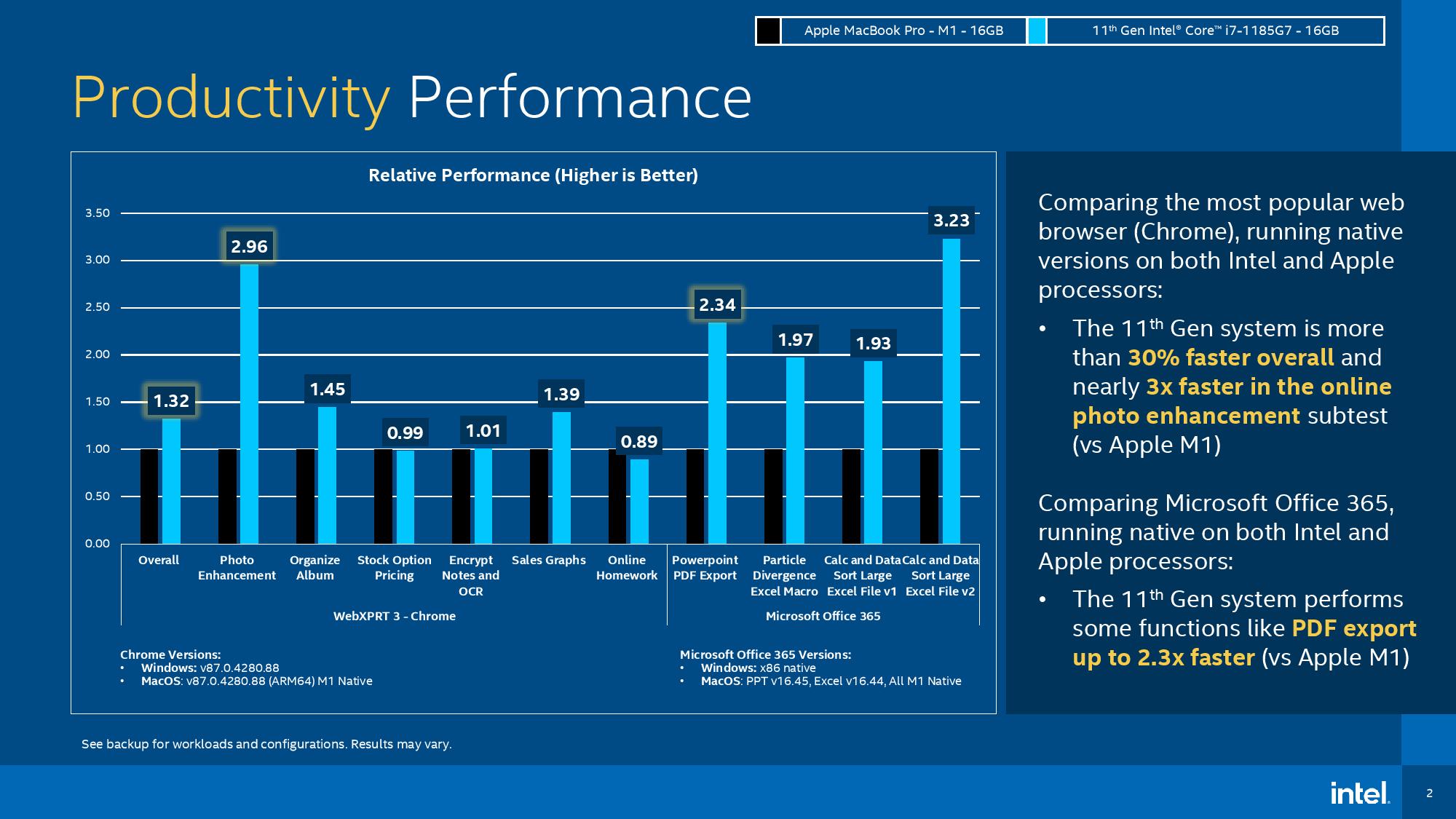
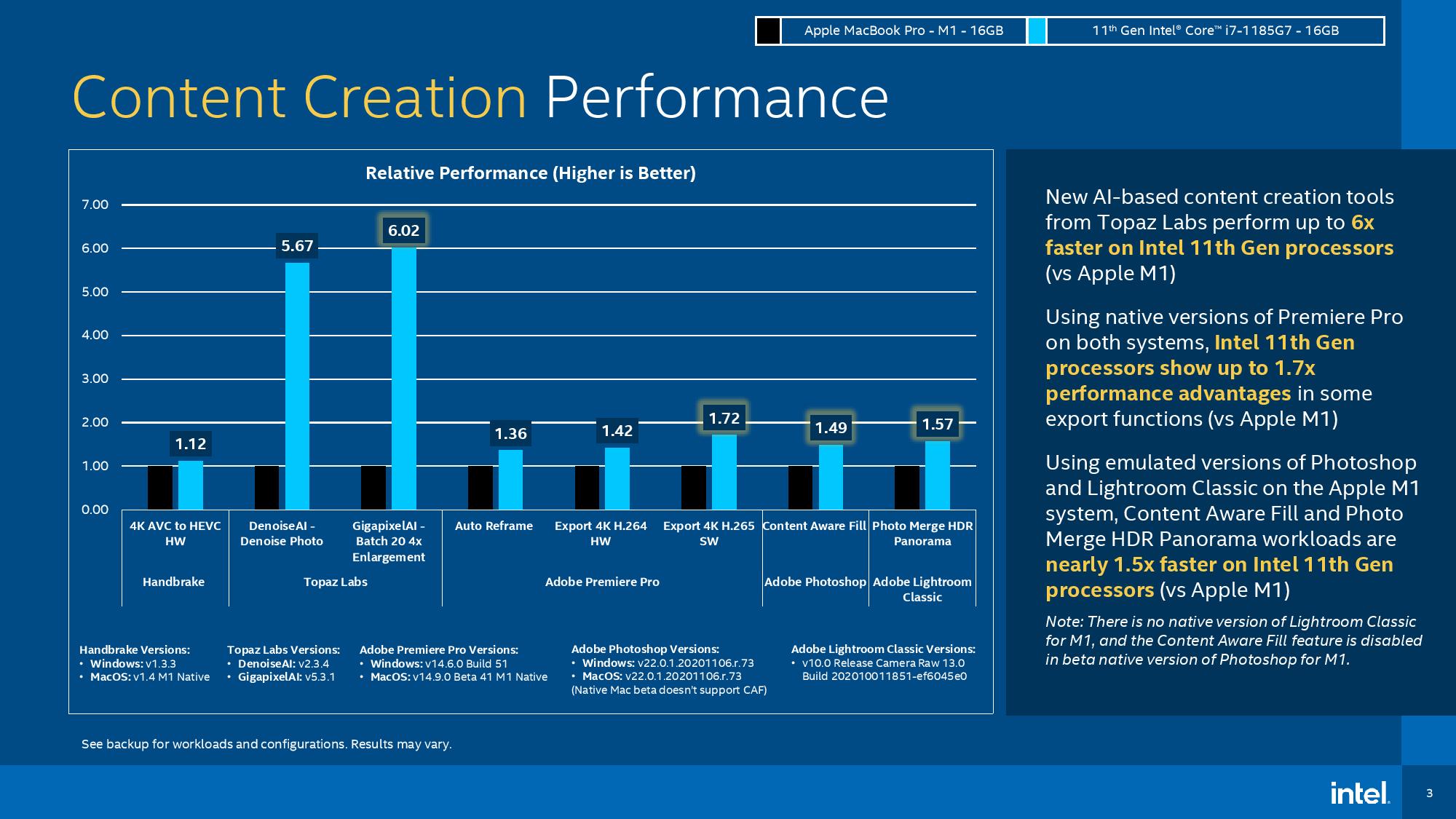
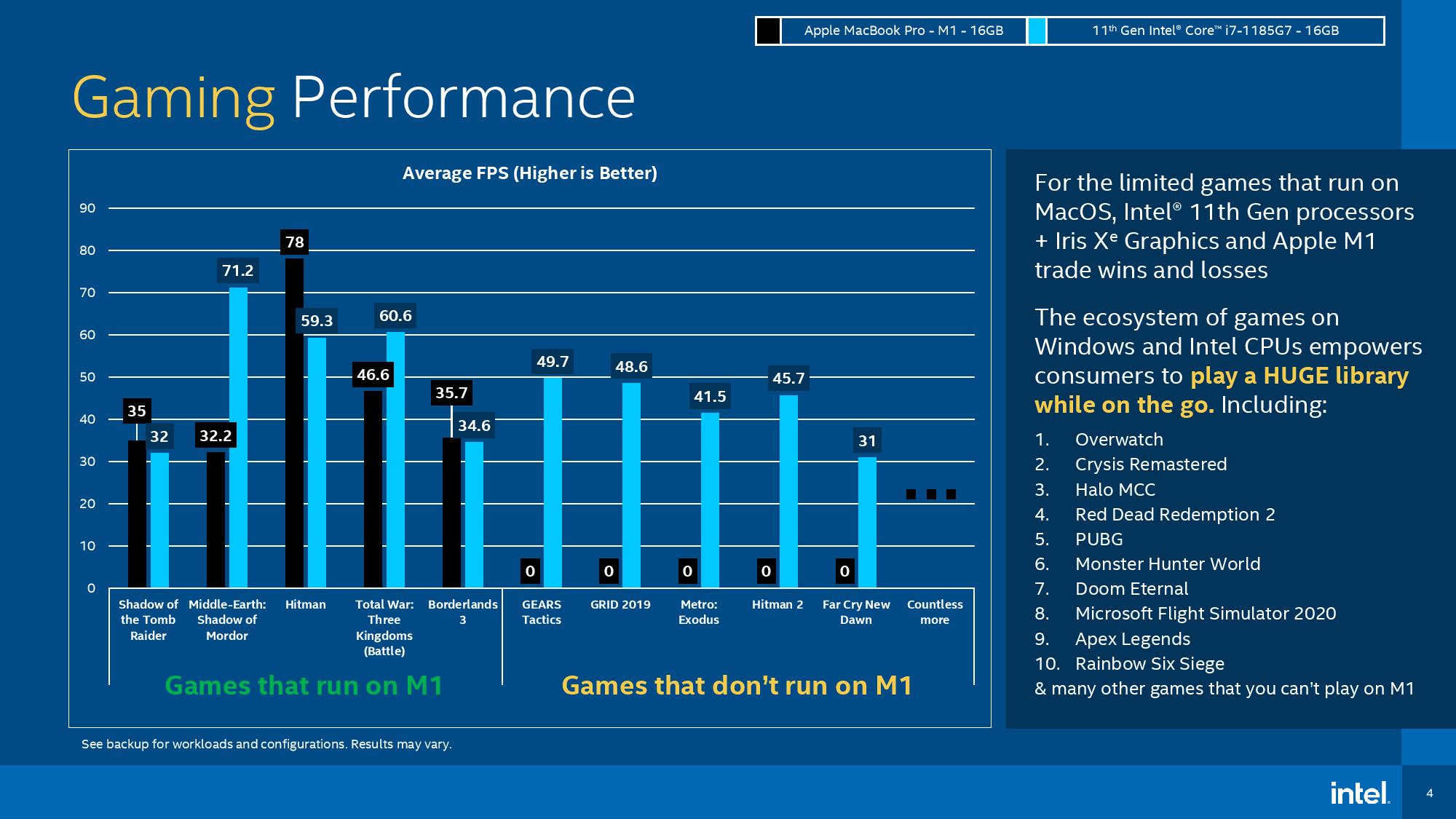
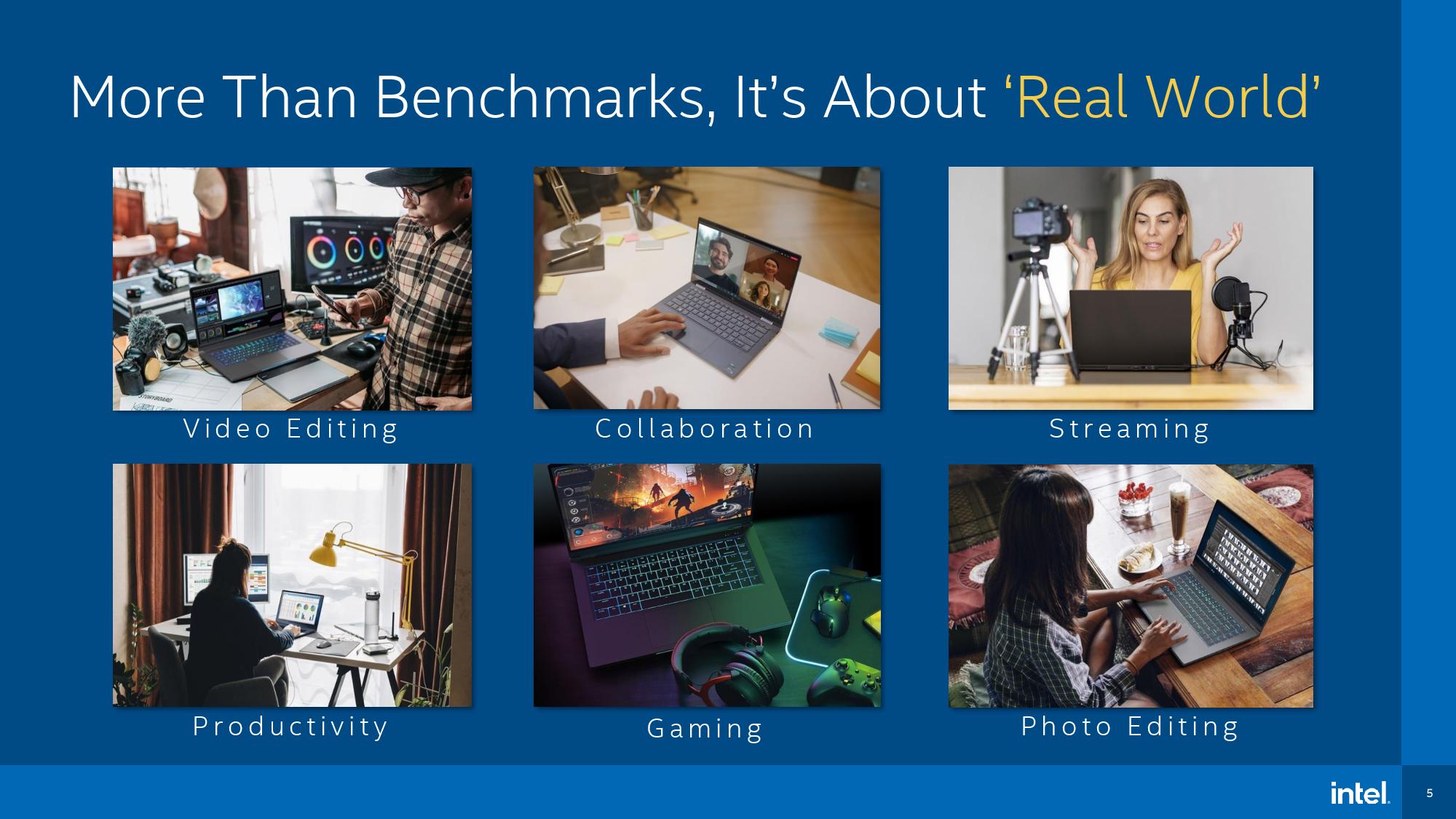
For productivity apps like Microsoft Office and Chrome, Intel is claiming based off WebXPRT3 and its own internal real-world usage guideline (or RUG) testing that it got 30% more performance off a testing whitebox with Intel Core i7-1186G7 and 16GB of RAM than it did against a competing system with M1 and 16GB of RAM.
This goes against what we saw when we reviewed the MacBook Pro with M1. Additionally, we haven't seen many laptops opt for the i7-1185G7 over the i7-1165G7 yet, outside of the MSI Prestige Evo 14.
Internal RUG tests from Intel also show the i7-1185G7 beating the M1 on Adobe apps and AI tools from Topaz labs, as it supposedly completed tasks at six times the speed of the M1.
Gaming was more even, though Intel's benchmarks coyly tease Apple for a number of games that don't have Mac support by claiming the M1 runs them at "0 fps."
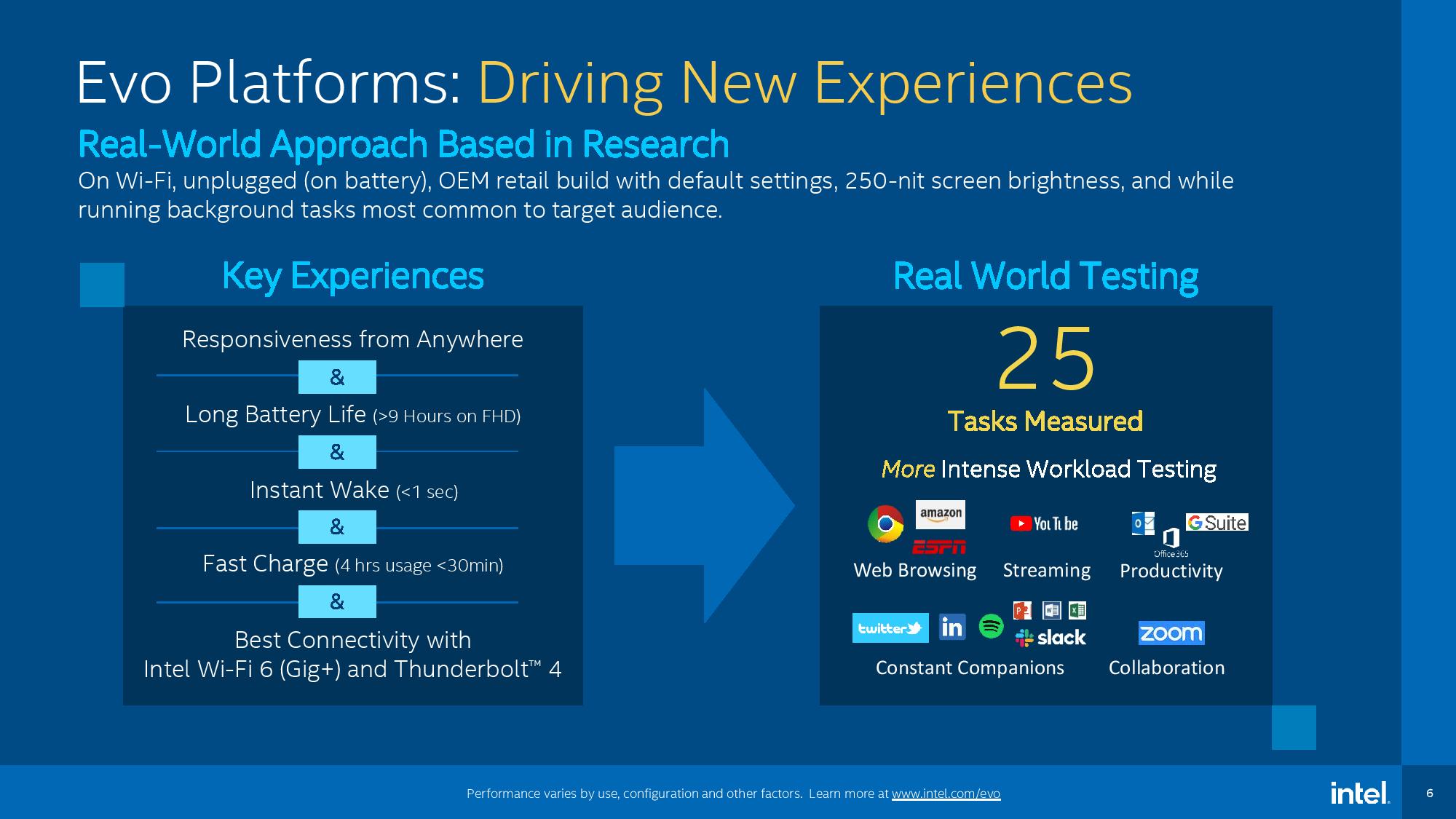
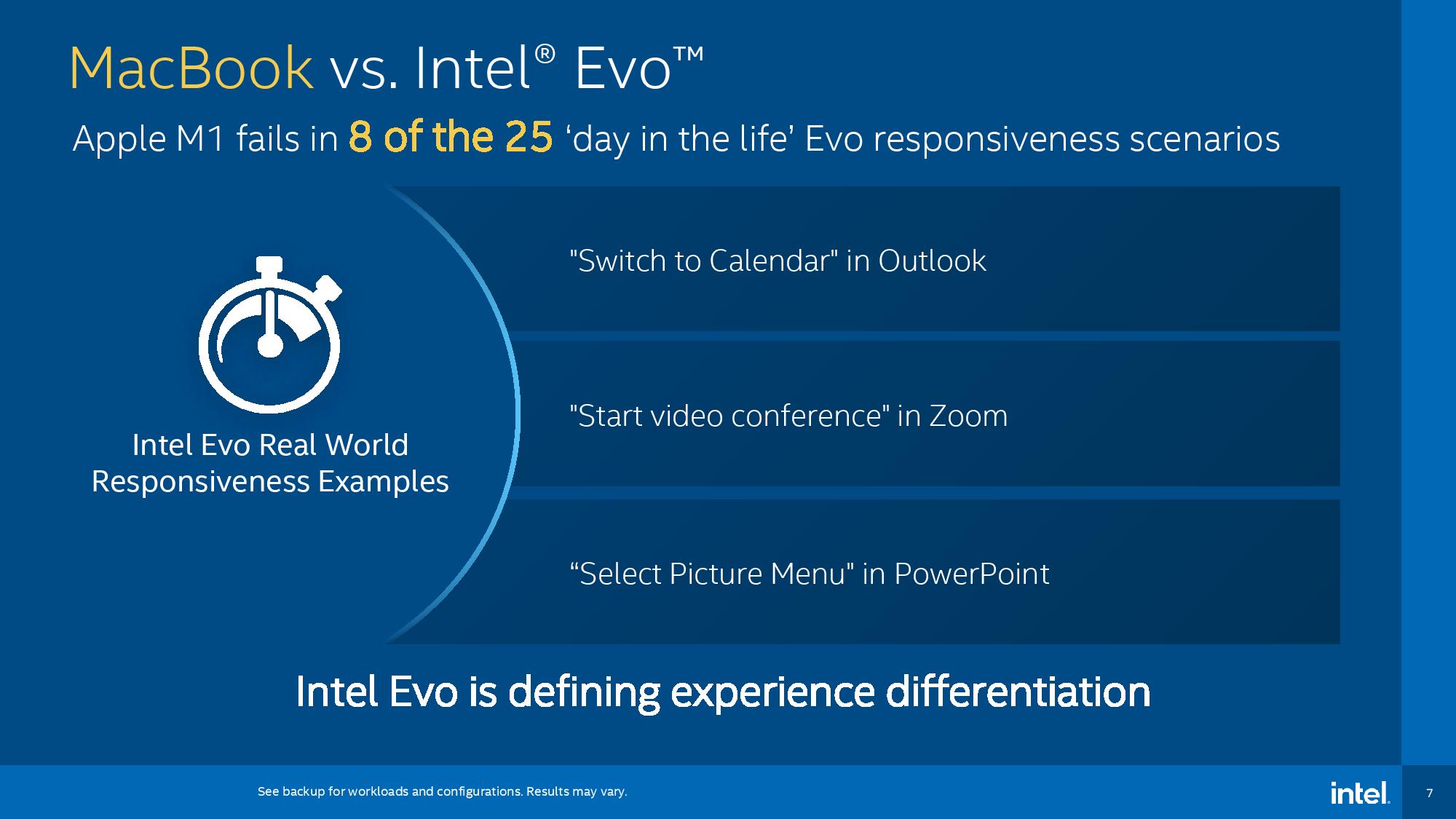
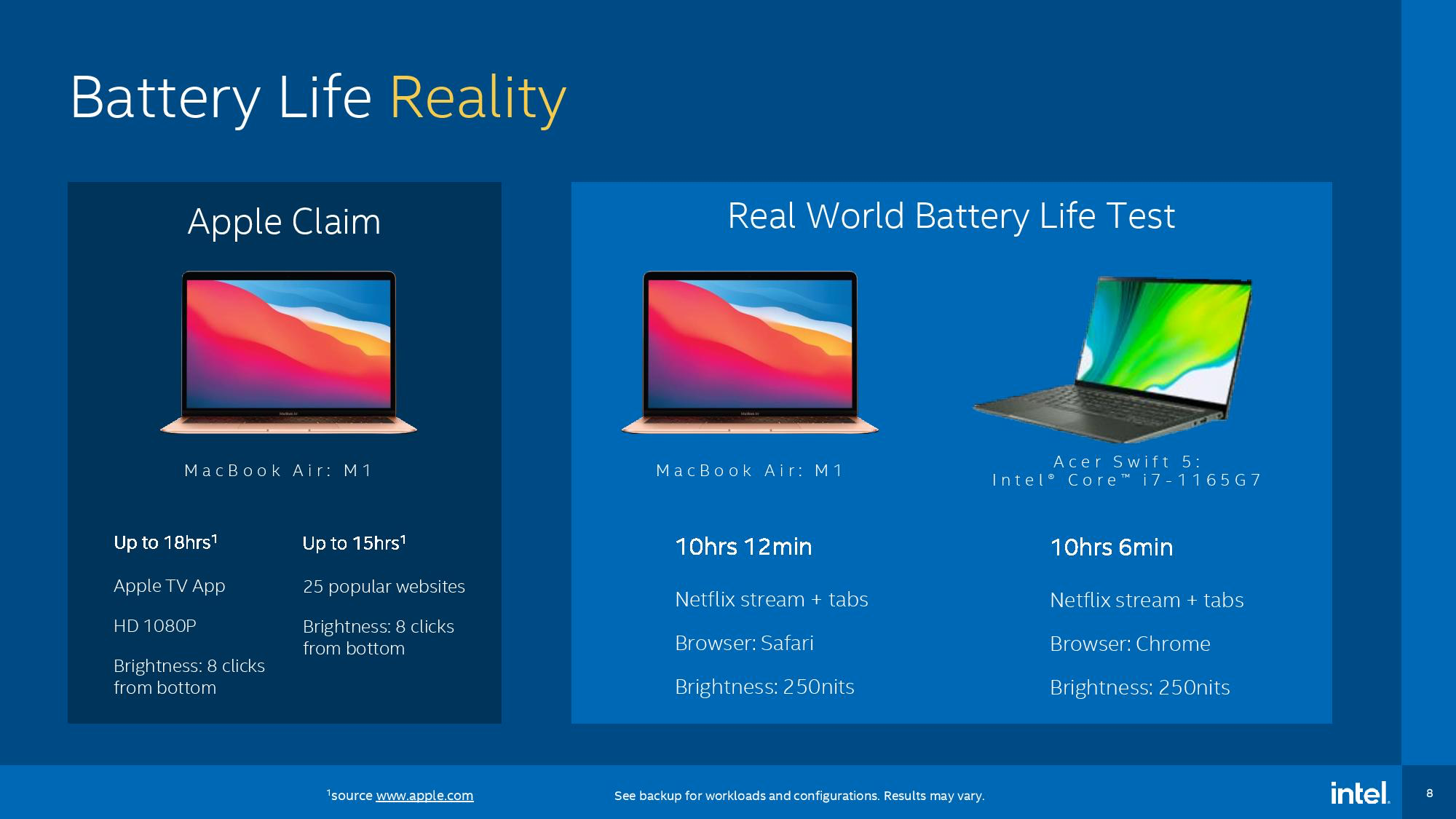
Intel also took aim at Apple for supposedly not performing as well on the specific tests that manufacturers must pass to get its "Intel Evo" certification. These are meant, according to Intel's studies, to provide a better notebook experience, and include tasks like "switching to Calendar" in Outlook and "starting a video conference in Zoom" as quickly as possible.
Intel hasn't made it clear how these tests were run, though these are generally pretty simple tasks that run well on most modern systems, so we're talking miniscule gains here.
It's also worth noting that Intel swapped to a MacBook Pro with 8GB of RAM for testing here, as opposed to the 16GB it used when testing performance.
Battery life is also part of Evo certification, and when stacking the Acer Swift 5 against the MacBook Air in a test for which laptop could stay alive longer when running a Netflix stream alongside multiple browser tabs, Intel found the MacBook Air came ahead with 6 minutes more life.
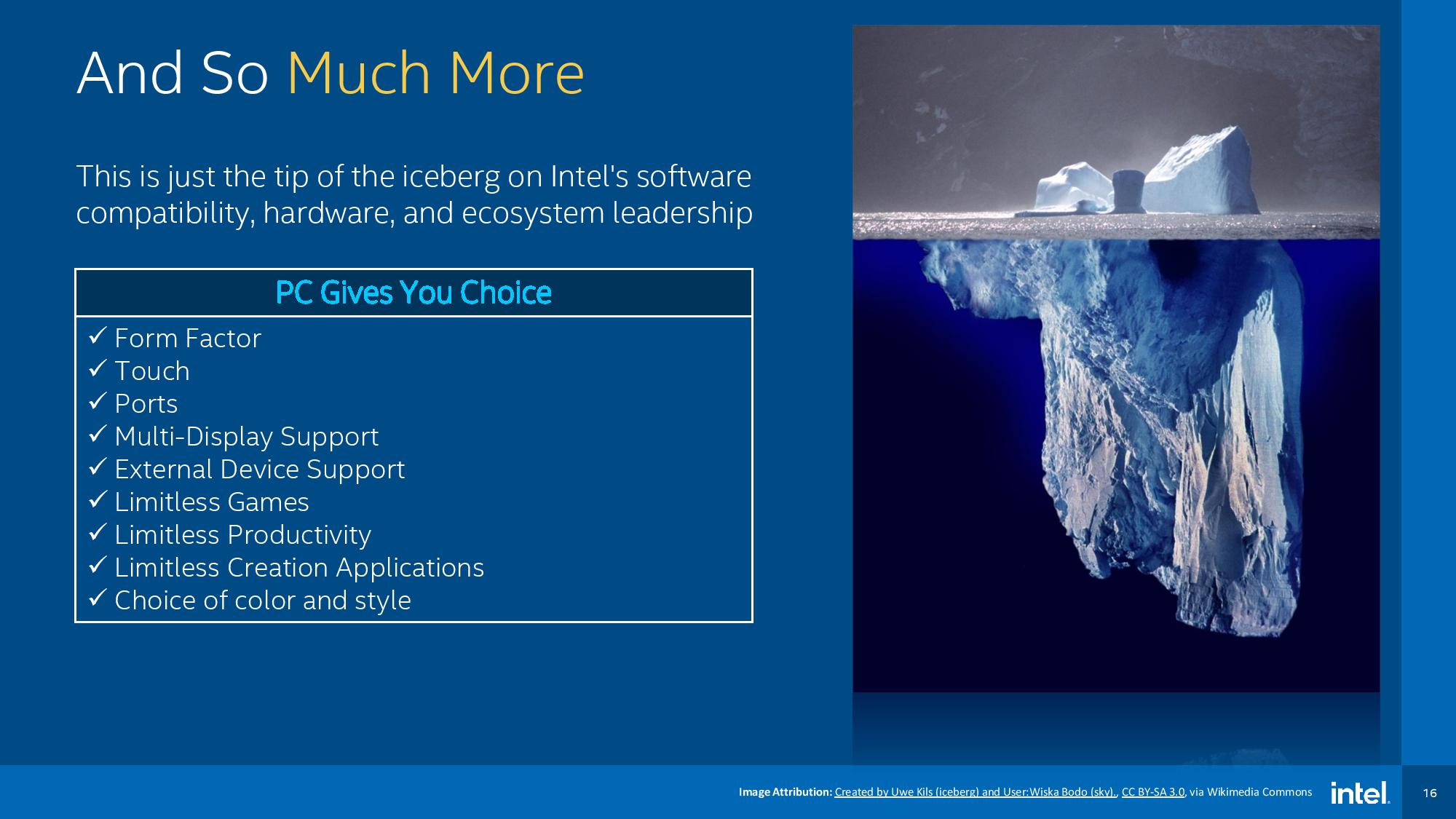
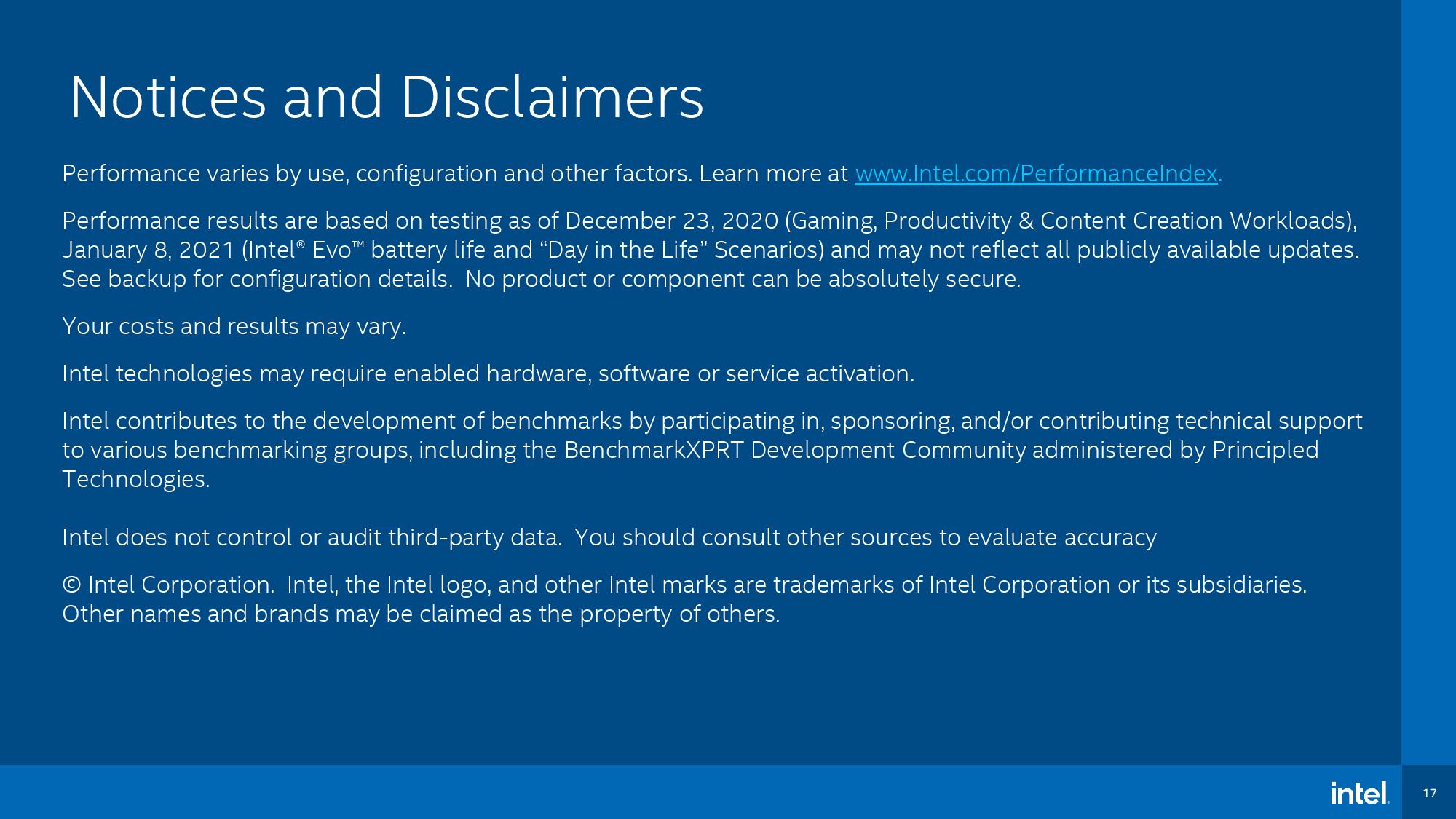

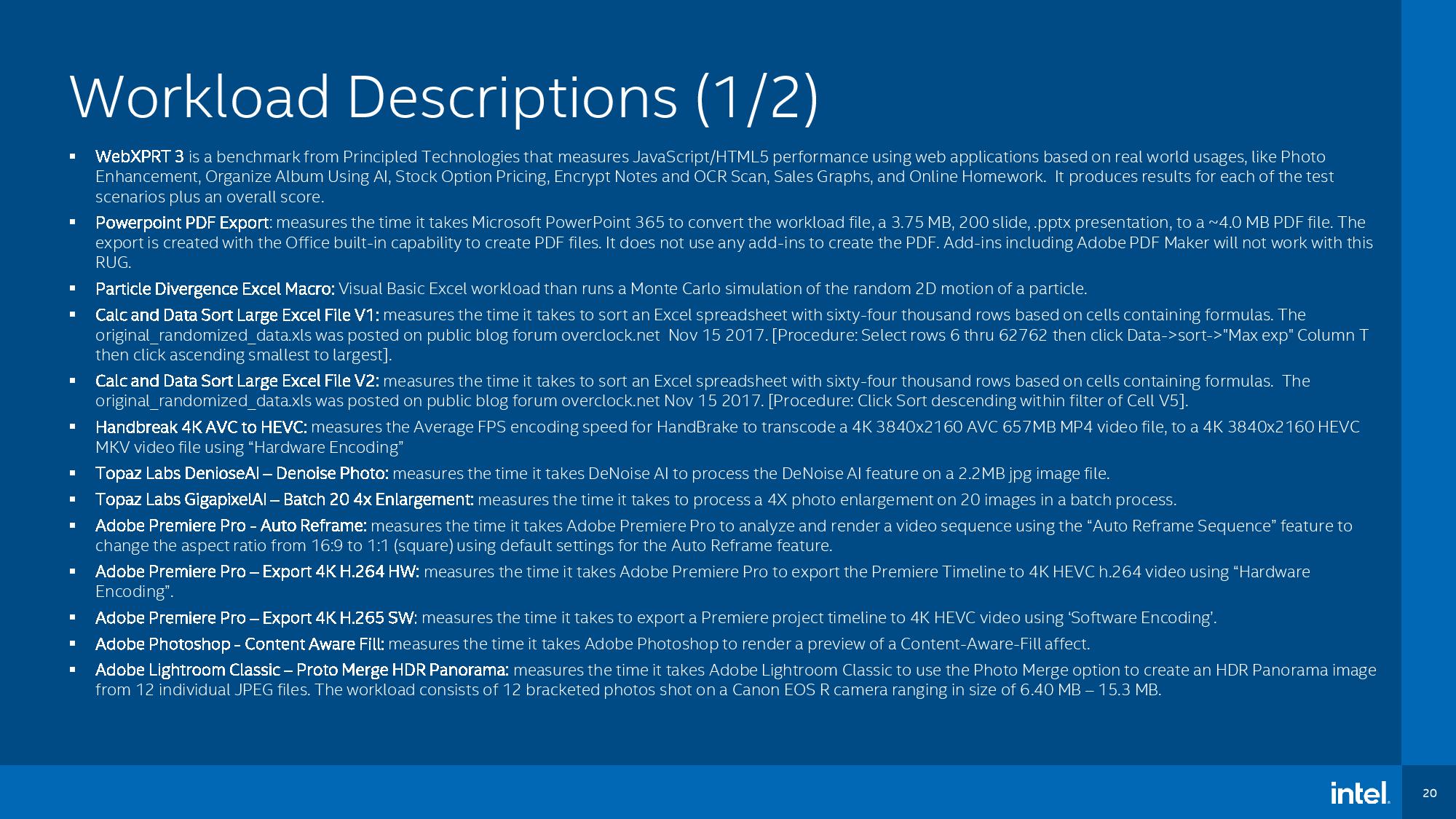
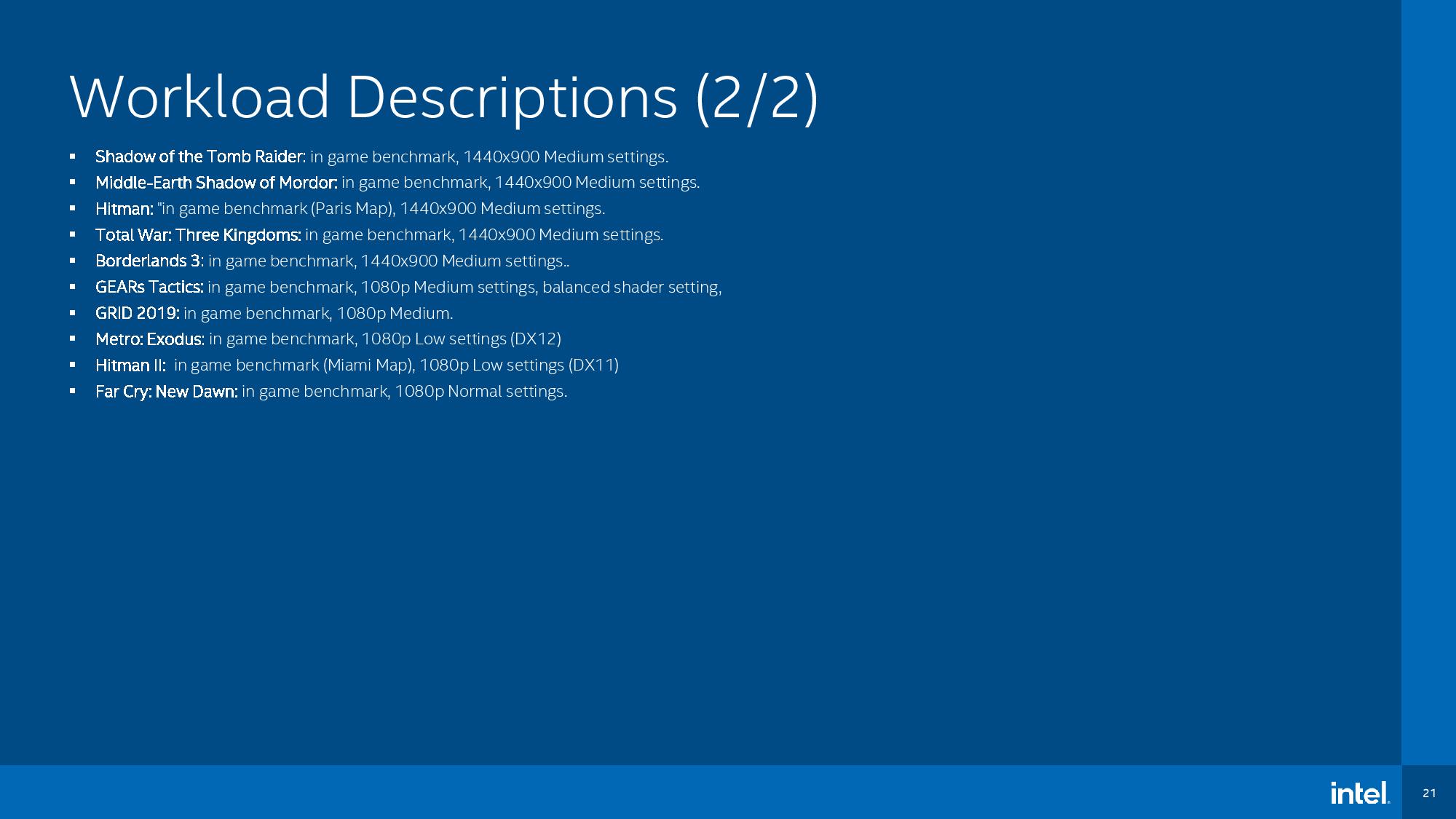
Intel also included a number of disclaimers along with its tests, plus digs at the lack of touchscreen or diverse form factor options on MacBooks as well as the difficulty in using more than one external display with Apple M1 devices. The company also targeted the limitations of Apple M1's x86 emulation, which we discussed above.
Intel's also gone hard on advertising against Apple, with a new "Go PC" ad campaign that's even gone far enough as hiring the old old "I'm a Mac" guy.
Michelle Ehrhardt is an editor at Tom's Hardware. She's been following tech since her family got a Gateway running Windows 95, and is now on her third custom-built system. Her work has been published in publications like Paste, The Atlantic, and Kill Screen, just to name a few. She also holds a master's degree in game design from NYU.
-
DZIrl Your own Dell Geekbench 5.2 scored 5,319.Reply
Dell uses i7-1065G7 what is 12W, year old CPU.
Not so bad compared to M1 6,292.
Not to forget AMD is faster then Intel and 7nm should be lower power. -
power_vano Guys, your sister website, AnandTech has done a good review: https://www.anandtech.com/show/16252/mac-mini-apple-m1-testedReply
And you are citing some random Geekbench, Engadget and The Verge? -
nofanneeded Replypower_vano said:Guys, your sister website, AnandTech has done a good review: https://www.anandtech.com/show/16252/mac-mini-apple-m1-tested
And you are citing some random Geekbench, Engadget and The Verge?
Paid review by Apple .
For example , CineBench R23
in single thread , they put Ryzen 5950X to impress , but in Multi core , it disappears and only the 4900hs is there ..
Funny right ?
More over the Mac Mini is a desktop not a mobile PC , Apple could put 65/100 watts CPU in that case ... and yet they are using it for a 20 watts CPU ..
meh .. -
TJ Hooker Reply
It's technically a desktop, but its form factor is similar to an Intel NUC-like device, which typically use ~25W mobile chips. Because of this I think it makes sense to not include the 5950X in the multithread tests. For those you're going to be thermal/power limited, and comparing performance between chips drawing ~30W (maybe up to ~50W for short durations) and chips that can draw ~140W indefinitely really isn't a very interesting comparison IMO.nofanneeded said:More over the Mac Mini is a desktop not a mobile PC , Apple could put 65/100 watts CPU in that case ... and yet they are using it for a 20 watts CPU .. -
nofanneeded ReplyTJ Hooker said:It's technically a desktop, but its form factor is similar to an Intel NUC-like device, which typically use ~25W mobile chips. Because of this I think it makes sense to not include the 5950X in the multithread tests. For those you're going to be thermal/power limited, and comparing performance between chips drawing ~30W (maybe up to ~50W for short durations) and chips that can draw ~140W indefinitely really isn't a very interesting comparison IMO.
Actually , MAC Mini 2018 had Core i7 8700B CPU , 6 cores 12 threads upto 64GB RAM
With TDP of 65Watts . and in the same case .
apple could put ANY 65 watts in that case.
https://www.mac4sale.co.uk/refurbished-apple-mac-mini-8-1-i7-8700b-32gb-ram-128gb-ssd-a-late-2053.html
full specs
https://everymac.com/systems/apple/mac_mini/specs/mac-mini-core-i7-3.2-late-2018-specs.html
i7 8700b
https://ark.intel.com/content/www/us/en/ark/products/134905/intel-core-i7-8700b-processor-12m-cache-up-to-4-60-ghz.html
This Mac Mini could take Ryzen 5 5600X , intel i9 10900 (10 cores) , i7 10700 ...
and also the coming 11 GEN with XE Grpahics.
Apple Gone crazy moving to ARM. -
byte99 Reply
What's "funny" is you don't seem to realize that, while the Ryzen 4900HS has 8 fast cores, the M1 has only four (plus four efficiency cores). Hence the M1 is expected to be at a disadvantage when compared to a conventional 8-core CPU for multi-core tasks. Note that both the 4900HS and the 4800U have R23 multi-core scores about 8x their single-core scores. Next year Apple will be releasing higher-powered chips, likely including 8 or more high-performance cores. With 8 performance cores, it should be able to score >12,000 on the R23 multithread benchmark, handily beating the 4900HS—and at a lower power consumption. I predict such a chip will be made available for the Mac Mini.nofanneeded said:Paid review by Apple .
For example , CineBench R23
in single thread , they put Ryzen 5950X to impress , but in Multi core , it disappears and only the 4900hs is there ..
Funny right ?
More over the Mac Mini is a desktop not a mobile PC , Apple could put 65/100 watts CPU in that case ... and yet they are using it for a 20 watts CPU ..
meh ..
But for now, they offered a lower-end Mac Mini based on the only chip they had available thus far. They could have only offered an M1 Air, but it was better that they also offered an M1 Mini and and an M1 MBP, since that increases consumer choice during the initial introductory period.
It's also unfortunate you are falsely accusing Anandtech -- a very reputable site -- of being shills for Apple, just because you don't like the facts they reported. -
nofanneeded Replybyte99 said:What's "funny" is you don't seem to realize that, while the Ryzen 4900HS has 8 fast cores, the M1 has only four (plus four efficiency cores). Hence the M1 is expected to be at a disadvantage when compared to a conventional 8-core CPU for multi-core tasks. Note that both the 4900HS and the 4800U have R23 multi-core scores about 8x their single-core scores. Next year Apple will be releasing higher-powered chips, likely including 8 or more high-performance cores. With 8 performance cores, it should be able to score >12,000 on the R23 multithread benchmark, handily beating the 4900HS—and at a lower power consumption. I predict such a chip will be made available for the Mac Mini.
But for now, they offered a lower-end Mac Mini based on the only chip they had available thus far. They could have only offered an M1 Air, but it was better that they also offered an M1 Mini and and an M1 MBP, since that increases consumer choice during the initial introductory period.
It's also unfortunate you are falsely accusing Anandtech -- a very reputable site -- of being shills for Apple, just because you don't like the facts they reported.
you dont get it , Once you put CPU results in one thread , you should put the same CPU in the multi thread tables. they hidden it because it is embarrassing to Apple ..
More over , as I said earlier , Mac Mini is a desktop capable of having any 65 watts CPU inside. they ruined it when they offered it 2 years LATER with 20 watts CPU ...
it is not a Mobile . MAc Mini is a DESKTOP.
Late 2018 had i7 8700b with upto 64GB of RAM ..
Two years after they gave us 16 GB RAM MAX and some tiny 20 watts CPU ? while they could put i9 10900 inside and upto 128GB of max ram ?
New Mac mini is a downgrade AFTER TWO YEARS. not acceptable at all. -
byte99 Replynofanneeded said:you dont get it , Once you put CPU results in one thread , you should put the same CPU in the multi thread tables. they hidden it because it is embarrassing to Apple ..
I get it just fine. I'm a scientist, so it's my job to think about how to present data in a clear and non-misleading manner. When you say that anandtech "deliberately hid" the 5950x multicore result, and did so because it's "embarrassing to Apple", along with your earlier comment that Apple must have paid anandtech off, you're spouting conspiracy theories.
Most likely, the reason they left it off is that they didn't think it was meaningful or interesting to compare a CPU with 4 performance cores and 4 low-power cores to a CPU with 16 performance cores, for a multi-core task! I.e., just because a single-core comparison is meaningful, that doesn't mean a multi-core comparison is as well. If anything, the graph was unfair to the M1. If it were me, I would have added, to each result in the multi-core comparison, a label with the number of performance cores and the number of efficiency cores, so people could clearly see that, in most cases, the M1 was being compared to CPUs with more performance cores.
As further evidence that anandtech isn't trying to "hide" anything, they explicitly wrote, in their article, that "Naturally, in higher power-level, higher-core count systems, the M1 can’t keep up to AMD and Intel designs, but that’s something Apple likely will want to address with subsequent designs in that category over the next 2 years."
I think you're the one who's not getting it here. I agree, Apple should (and likely will) offer a high-end version of the Mini, with 4 TB4 ports, higher RAM options, and a more powerful CPU/GPU. But think it through: They don't have such a chip now. So they only had two options:nofanneeded said:More over , as I said earlier , Mac Mini is a desktop capable of having any 65 watts CPU inside. they ruined it when they offered it 2 years LATER with 20 watts CPU ...
it is not a Mobile . MAc Mini is a DESKTOP.
Late 2018 had i7 8700b with upto 64GB of RAM ..
Two years after they gave us 16 GB RAM MAX and some tiny 20 watts CPU ? while they could put i9 10900 inside and upto 128GB of max ram ?
New Mac mini is a downgrade AFTER TWO YEARS. not acceptable at all.
Offer a low-end AS Mini now (keeping the Intel Mini for those who need the added ports and RAM), and add a high-end AS Mini to the line in 2021 when the more powerful chips become available.
Delay offering the low-powered AS Mini until the high-powered one is also available, releasing both together in 2021. And by complaining they released only a low-end Mini now, you're basically complaining they did no. 1 instead of no. 2. But why on earth is no. 2 better for the consumer than no. 1?? All it does is deny consumers who might benefit from a low powered AS Mini today the ability to purchase that version until the the high-powered one is available. Your position makes no sense.
I.e., they're only offering a low-powered AS Mini for now, because that's the only production AS Mac chip they currently have. Those consumers for whom that works can buy it now. Those that need more power/ports/RAM can wait for the high-powered Mini. -
nofanneeded Replybyte99 said:I think you're the one who's not getting it here. I agree, Apple should (and likely will) offer a high-end version of the Mini, with 4 TB4 ports, higher RAM options, and a more powerful CPU/GPU. But think it through: They don't have such a chip now. So they only had two options:
Offer a low-end AS Mini now (keeping the Intel Mini for those who need the added ports and RAM), and add a high-end AS Mini to the line in 2021 when the more powerful chips become available.
Delay offering the low-powered AS Mini until the high-powered one is also available, releasing both together in 2021.And by complaining they released only a low-end Mini now, you're basically complaining they did no. 1 instead of no. 2. But why on earth is no. 2 better for the consumer than no. 1?? All it does is deny consumers who might benefit from a low powered AS Mini today the ability to purchase that version until the the high-powered one is available. Your position makes no sense.
I.e., they're only offering a low-powered AS Mini for now, because that's the only production AS Mac chip they currently have. Those consumers for whom that works can buy it now. Those that need more power/ports/RAM can wait for the high-powered Mini.
This makes no sense ,
First : Apple Did not promise anything better in the near future for MAC Mini. Nor Any plans for near future CPU.
Second : Apple takes LONG time to update their Mac Mini Line , Minimum 2 years in between.
Third : multi cores i7 10700 Cinebench R23 is at ~12250 , and i9 10900 at near 16000 , while both use only 65 watts and both could fit inside the Mac mini Case and cooling , while Apple M1 is just at 7800 native and 5250 emulated .. in the 2020 MAC mini . This is nothing but a steep downgrade for people who always wait for the next MAC Mini. we are talking about more than 50% loss of performance here .
Fourth : MAC Mini 2018 with the i7 8700B (65watts) Cinebench R23 score is 7969 , so what did Apple give us after 2 years ? cine R23 = 7800 and 5250 (emulation) yea Right .
Fifth : At least Apple could have offered us two versions of MAC Mini , one with M1 and one with Intel i9 10900 ... or maybe some special version of AMD Ryzen 3 with 12 cores tuned down to 65 watts that would score near 20,000 R23 (the 5900X scores 21,878)
and finally , It is impossible for Apple for the time being to make any ARM CPU with 20 Threads or 10 big 10 little , FORGET IT .. we already have the i9 10900 (20 threads) 65 watts and it is a wonderful CPU for the MAC Mini and I was Expecting it (Actually I was expecting the 11th Gen with Xe in the new Mac Mini) . now no more macs for me.
Cinebench R23 Multi cores source :
https://www.cpu-monkey.com/en/cpu_benchmark-cinebench_r23_multi_core-16
